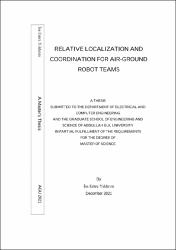| dc.contributor.author | Yıldırım, İsa Emre | |
| dc.date.accessioned | 2022-06-20T09:04:04Z | |
| dc.date.available | 2022-06-20T09:04:04Z | |
| dc.date.issued | 2021 | en_US |
| dc.date.submitted | 2021-12 | |
| dc.identifier.citation | A THESIS SUBMITTED TO THE DEPARTMENT OF ELECTRICAL AND COMPUTER ENGINEERING
AND THE GRADUATE SCHOOL OF ENGINEERING AND SCIENCE OF ABDULLAH GUL UNIVERSITY
IN PARTIAL FULFILLMENT OF THE REQUIREMENTS FOR THE DEGREE OF MASTER OF SCIENCE | en_US |
| dc.identifier.uri | https://hdl.handle.net/20.500.12573/1289 | |
| dc.description.abstract | Recently, autonomous robot teams have been implemented broadly in many social and military applications such as firefighting, agriculture, search and rescue, mapping, target tracking, and docking. A mix of different types of ground robots and aerial vehicles can be employed in a robot team to accomplish tasks efficiently and robustly. Such heterogeneous systems show unparalleled benefits in complex tasks compared to teams composed of identical robot types. In a heterogeneous robot team, precise relative localization, i.e., estimating a robot’s position with respect to its neighbor robots, plays a key role. We develop a relative localization system for air-ground robot teams where an aerial vehicle and multiple ground robots work in coordination to perform a reliable relative position estimation. The aerial vehicle is employed to detect special patterns on the ground robots by an onboard monocular camera, while the ground robots perform relative position estimation based on inter-robot distances acquired by ultrawideband sensors and the bearing and heading angles received from the aerial vehicle by communication. Thus, the aerial vehicle serves as an absolute frame provider for the entire team. Notably, each robot in the team uses onboard communication and computation capabilities solely without any need for an external localization infrastructure, making the team realizable in all conditions including GNSS-denied environments. We propose a multi-rate extended Kalman filter algorithm to handle different data rates of the sensor measurements. We carried out an extensive simulation study with a drone and five ground robots in a leader-first follower formation. Simulation results showed a successful estimation performance with an error rate of up to five centimeters in the relative position estimations in both axes. | en_US |
| dc.description.abstract | Son yıllarda, otonom robotlar yangın söndürme, tarım, arama kurtarma, haritalandırma, hedef takibi ve yönelme gibi bir çok sosyal ve askeri uygulamalarda yaygınca kullanılmıştır. Görevleri verimli ve gürbüz bir şekilde tamamlamak için bir robot takımı içerisinde çeşitli tiplerde yer robotları ve hava araçları kullanılabilmektedir. Bu tür heterojen sistemler, karmaşık görevlerin icrasında tek tip robotlardan oluşan takımlara göre benzersiz faydalar sunmaktadır. Heterojen bir robot takımında, hassas bağıl konumlandırma-bir robotun komşularına göre konumunu tahmin etmesi-önemli bir yere sahiptir. Hava-yer robot takımları için, bir hava aracının ve çok sayıda yer robotunun koordineli bir şekilde bağıl konum tahminini gerçekleştirdiği bir bağıl konumlandırma sistemi türetiyoruz. Hava aracı, üzerindeki mono kamerasıyla yer robotları üzerindeki özel örgüleri teşhis ederken, yer robotları da ultrawideband sensörlerden aldıkları robotlar arası mesafeleri ve hava aracından iletişimle aldıkları yönelme açısı ve duruş açısına göre bağıl konum tahmini gerçekleştirmektedirler. Böylece, hava aracı, bütün takım için mutlak düzlem sağlayıcısı olarak görev yapmaktadır. Özellikle, takımdaki her bir robot herhangi bir dış konumlandırma altyapısına ihtiyaç duymadan üzerindeki iletişim ve hesaplama yeteneklerini kullanmaktadır ve bu özellik takımı GNSS olmayan çevreler de dahil olmak üzere her koşulda gerçeklenebilir yapmaktadır. Farklı hızlara sahip sensor ölçümlerini işlemek için bir çok-oranlı genişletilmiş Kalman filtresi önermekteyiz. Bir dron ve lider-ilk takipçi formasyonunda beş yer robotu ile kapsamlı bir simülasyon çalışması gerçekleştirdik. Simülasyon sonuçları her iki eksendeki bağıl konum tahmininde beş santimetreye kadar hata payı olan başarılı bir tahmin performansı göstermiştir. | en_US |
| dc.description.tableofcontents | TABLE OF CONTENTS
1. INTRODUCTION .................................................................................................... 1
1.1 RELATED WORKS ..................................................................................................... 2
1.2 ORGANIZATION ...................................................................................................... 11
2. SYSTEM DEFINITION ......................................................................................... 12
2.1 MULTI-ROBOT SYSTEM MODEL ............................................................................. 13
2.1.1 Motion Models of the Ground Robots............................................................ 13
2.1.2 Kinematic Model of the Drone....................................................................... 14
2.1.3 Dynamic Models of the Robots ...................................................................... 15
2.1.4 Dynamic Model of the Drone......................................................................... 16
2.2 PROBLEM DEFINITION ............................................................................................ 17
3. RELATIVE LOCALIZATION AND COORDINATION .................................. 19
3.1 FORMATION GRAPH ............................................................................................... 19
3.2 SYSTEM FRAMEWORK ............................................................................................ 20
3.3 MULTI-RATE EKF DESIGN .................................................................................... 23
3.3.1 Motion Model ................................................................................................. 23
3.3.2 Measurement Models ..................................................................................... 24
3.3.3 Distance-based Bearing Calculation ............................................................. 27
4. SIMULATION ........................................................................................................ 30
4.1 SIMULATION ENVIRONMENT .................................................................................. 30
4.2 FORMATION MODEL ............................................................................................... 31
4.3 PATTERN DETECTION ............................................................................................. 32
4.4 SIMULATION RESULTS ........................................................................................... 35
5. EXPERIMENT ....................................................................................................... 43
5.1 EXPERIMENT SETUP ............................................................................................... 43
5.2 RESULTS ................................................................................................................ 46
6. CONCLUSIONS AND FUTURE PROSPECTS ................................................. 50
6.1 CONCLUSIONS ........................................................................................................ 50
6.2 SOCIETAL IMPACT AND CONTRIBUTION TO GLOBAL SUSTAINABILITY................... 51
6.3 FUTURE PROSPECTS ............................................................................................... 52 | en_US |
| dc.language.iso | eng | en_US |
| dc.publisher | Abdullah Gül Üniversitesi Fen Bilimleri Enstitüsü | en_US |
| dc.rights | info:eu-repo/semantics/openAccess | en_US |
| dc.subject | Relative localization | en_US |
| dc.subject | Heterogeneous multi-robot systems | en_US |
| dc.subject | estimation algorithms | en_US |
| dc.subject | ultrawideband sensors | en_US |
| dc.title | RELATIVE LOCALIZATION AND COORDINATION FOR AIR-GROUND ROBOT TEAMS | en_US |
| dc.type | masterThesis | en_US |
| dc.contributor.department | AGÜ, Fen Bilimleri Enstitüsü, Elektrik ve Bilgisayar Mühendisliği Ana Bilim Dalı | en_US |
| dc.relation.publicationcategory | Tez | en_US |


















